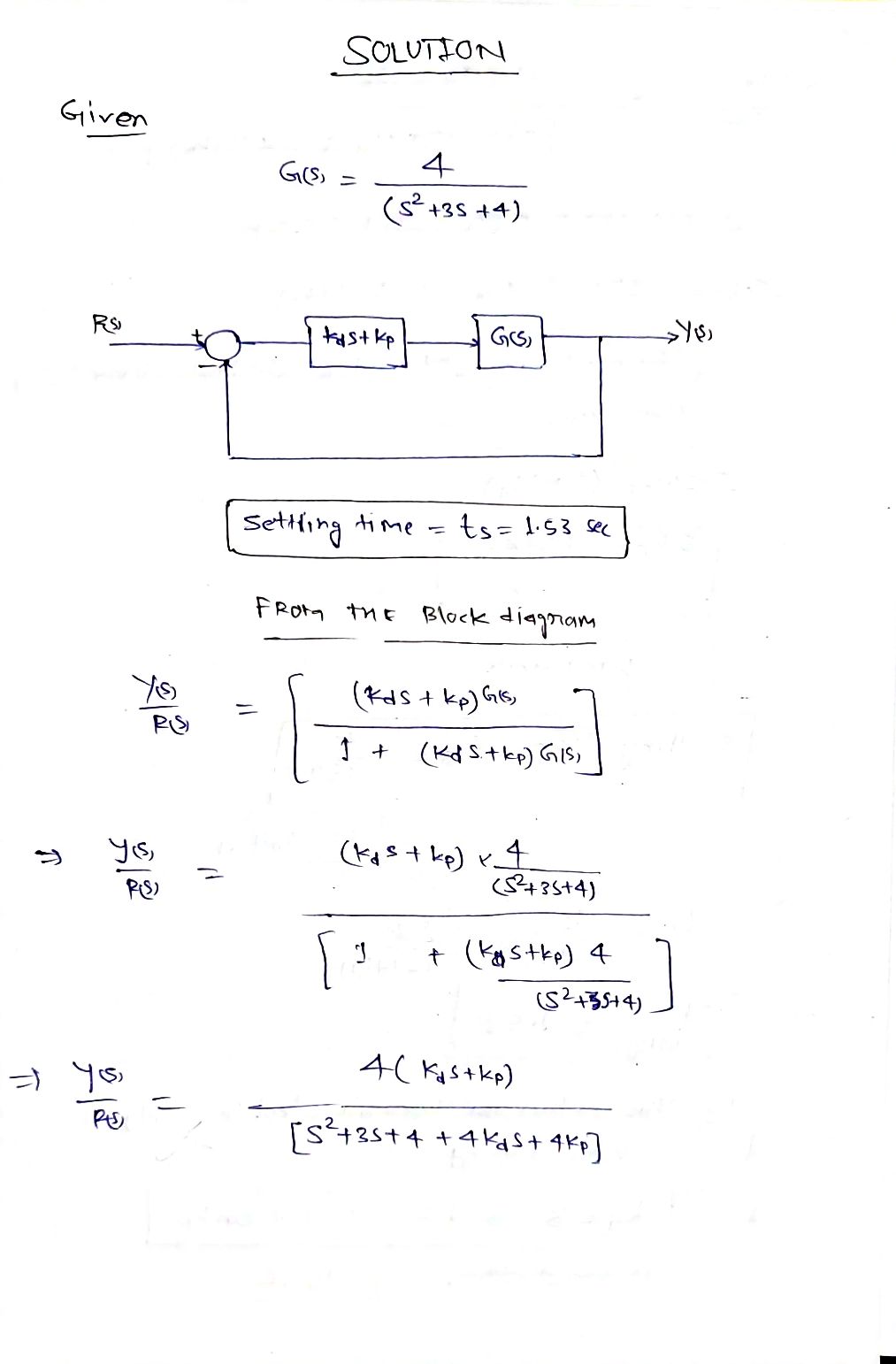Consider the following closed-loop system including plant G(s) = 4 s²+38+4 and PD controller. What are the requirements on Kd and Kp to achieve the desired closed loop transient specifications to a step reference input? Assume for this problem that you can ignore the effect of the closed-loop zero on the step response. R(s) Kas+Kp Closed-loop step response specifications: • no specification on rise time • settling time t, = 1.53 seconds .no specification on percent overshoot O K₂=5, no requirement on Kd O K₂=5, Kd=1 O Ka-3, no requirement on Kp O K₂=3, Kd=4 G(s) Y(s)
Consider the following closed-loop system including plant G(s) = 4 s²+38+4 and PD controller. What are the requirements on Kd and Kp to achieve the desired closed loop transient specifications to a step reference input? Assume for this problem that you can ignore the effect of the closed-loop zero on the step response. R(s) Kas+Kp Closed-loop step response specifications: • no specification on rise time • settling time t, = 1.53 seconds .no specification on percent overshoot O K₂=5, no requirement on Kd O K₂=5, Kd=1 O Ka-3, no requirement on Kp O K₂=3, Kd=4 G(s) Y(s)
Introductory Circuit Analysis (13th Edition)
13th Edition
ISBN:9780133923605
Author:Robert L. Boylestad
Publisher:Robert L. Boylestad
Chapter1: Introduction
Section: Chapter Questions
Problem 1P: Visit your local library (at school or home) and describe the extent to which it provides literature...
Related questions
Question
![Consider the following closed-loop system including plant:
\[ G(s) = \frac{4}{s^2 + 3s + 4} \]
and PD controller. What are the requirements on \( K_d \) and \( K_p \) to achieve the desired closed-loop transient specifications to a step reference input? Assume for this problem that you can ignore the effect of the closed-loop zero on the step response.
### Diagram Explanation:
The diagram illustrates a feedback control system where:
- \( R(s) \) is the reference input.
- The controller is defined by \( K_d s + K_p \).
- \( G(s) \) is the plant, with transfer function \( \frac{4}{s^2 + 3s + 4} \).
- \( Y(s) \) is the output.
### Closed-loop step response specifications:
- No specification on rise time.
- Settling time \( t_s = 1.53 \) seconds.
- No specification on percent overshoot.
### Options for \( K_p \) and \( K_d \):
- \( K_p = 5 \), no requirement on \( K_d \)
- \( K_p = 5 \), \( K_d = 1 \)
- \( K_d = 3 \), no requirement on \( K_p \)
- \( K_p = 3 \), \( K_d = 4 \)](/v2/_next/image?url=https%3A%2F%2Fcontent.bartleby.com%2Fqna-images%2Fquestion%2F2de2484e-8c30-4a24-aa43-7ad85b110ab5%2F8516312c-0102-49e7-869e-7edeedc0a529%2F6v5jdx4_processed.png&w=3840&q=75)
Transcribed Image Text:Consider the following closed-loop system including plant:
\[ G(s) = \frac{4}{s^2 + 3s + 4} \]
and PD controller. What are the requirements on \( K_d \) and \( K_p \) to achieve the desired closed-loop transient specifications to a step reference input? Assume for this problem that you can ignore the effect of the closed-loop zero on the step response.
### Diagram Explanation:
The diagram illustrates a feedback control system where:
- \( R(s) \) is the reference input.
- The controller is defined by \( K_d s + K_p \).
- \( G(s) \) is the plant, with transfer function \( \frac{4}{s^2 + 3s + 4} \).
- \( Y(s) \) is the output.
### Closed-loop step response specifications:
- No specification on rise time.
- Settling time \( t_s = 1.53 \) seconds.
- No specification on percent overshoot.
### Options for \( K_p \) and \( K_d \):
- \( K_p = 5 \), no requirement on \( K_d \)
- \( K_p = 5 \), \( K_d = 1 \)
- \( K_d = 3 \), no requirement on \( K_p \)
- \( K_p = 3 \), \( K_d = 4 \)
Expert Solution
Step 1

Step by step
Solved in 2 steps with 2 images

Knowledge Booster
Learn more about
Need a deep-dive on the concept behind this application? Look no further. Learn more about this topic, electrical-engineering and related others by exploring similar questions and additional content below.Recommended textbooks for you

Introductory Circuit Analysis (13th Edition)
Electrical Engineering
ISBN:
9780133923605
Author:
Robert L. Boylestad
Publisher:
PEARSON

Delmar's Standard Textbook Of Electricity
Electrical Engineering
ISBN:
9781337900348
Author:
Stephen L. Herman
Publisher:
Cengage Learning

Programmable Logic Controllers
Electrical Engineering
ISBN:
9780073373843
Author:
Frank D. Petruzella
Publisher:
McGraw-Hill Education

Introductory Circuit Analysis (13th Edition)
Electrical Engineering
ISBN:
9780133923605
Author:
Robert L. Boylestad
Publisher:
PEARSON

Delmar's Standard Textbook Of Electricity
Electrical Engineering
ISBN:
9781337900348
Author:
Stephen L. Herman
Publisher:
Cengage Learning

Programmable Logic Controllers
Electrical Engineering
ISBN:
9780073373843
Author:
Frank D. Petruzella
Publisher:
McGraw-Hill Education

Fundamentals of Electric Circuits
Electrical Engineering
ISBN:
9780078028229
Author:
Charles K Alexander, Matthew Sadiku
Publisher:
McGraw-Hill Education

Electric Circuits. (11th Edition)
Electrical Engineering
ISBN:
9780134746968
Author:
James W. Nilsson, Susan Riedel
Publisher:
PEARSON

Engineering Electromagnetics
Electrical Engineering
ISBN:
9780078028151
Author:
Hayt, William H. (william Hart), Jr, BUCK, John A.
Publisher:
Mcgraw-hill Education,